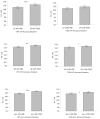Integrating Kata Training into School Education: Effects on Sustained Attention and Cognitive Performance in 8-9-Year-Old Children
- PMID: 40003310
- PMCID: PMC11854305
- DOI: 10.3390/children12020208
Integrating Kata Training into School Education: Effects on Sustained Attention and Cognitive Performance in 8-9-Year-Old Children
Abstract
(1) Background: The ability to sustain attention in primary school children aged 8-9 years plays a critical role in maintaining focus for extended periods, enabling them to comprehend and integrate large amounts of information. Enhancing sustained attention during this formative stage significantly improves a child's capacity to acquire and consolidate new skills and knowledge, laying a strong foundation for academic and cognitive development. (2) Objectives: This study aimed to assess the effect of an 8-week kata training program on attention and its components in 8-9-year-old school-age children, a critical developmental period for attention. (3) Methods: After excluding the participants who gave a low number of correct answers in the pre-test or created a ceiling effect, 43 participants, aged 9.12 ± 0.40 years, were included in this study. This study, conducted during the academic term, included three measurement phases and a familiarization session. Attention parameters were evaluated using the Bourdon-Vos Test, and participants were categorized into Low Performers (LP) and High Performers (HP) based on pre-test scores. The intervention group (INT) underwent kata training thrice weekly for 8 weeks, while the control group (CON) followed their regular activities. Post-training, attention parameters were reassessed using the Bourdon-Vos Test. (4) Results: In the post-intervention analysis, significant improvements in the number of correct responses were observed in both the LP (p < 0.001, Cohen's d = -1.333) and HP (p = 0.001, Cohen's d = -1.644) groups within the INT group. In the CON group, significant improvement was observed only in the HP group (p = 0.031, Cohen's d = -0.948). Regarding attention processing speed, significant pre-post improvements were found exclusively in the INT group (p < 0.001). Block-wise analysis revealed significant differences only in Block 1 of the CON group (p = 0.011, Cohen's d = -0.522). However, in the INT group, significant improvements were observed in both Block 1 (p < 0.001, Cohen's d = -1.200) and Block 2 (p = 0.004, Cohen's d = -0.678). (5) Conclusions: The findings of this study highlight the effectiveness of an 8-week kata training program in enhancing sustained attention and cognitive processing speed among 8-9-year-old children, particularly in low-performing groups. This suggests that integrating structured kata-based motor and cognitive activities into school curricula can serve as a promising strategy for addressing attention deficits and promoting cognitive development during this critical developmental period. Future studies should examine the long-term effects of kata training on attention and related cognitive functions, such as working memory and executive control. Investigating neurophysiological mechanisms through neuroimaging and including diverse age groups with larger samples could further validate these findings.
Keywords: academic achievement; cognitive processing speed; kata exercise; pre-school children; sustain attention.
Conflict of interest statement
The authors declare no conflicts of interest.
Figures






Similar articles
-
Time-course effects of exercise intervention on executive function in adolescents with obesity.Front Psychol. 2024 Sep 24;15:1346896. doi: 10.3389/fpsyg.2024.1346896. eCollection 2024. Front Psychol. 2024. PMID: 39380755 Free PMC article.
-
School-based interventions for reducing disciplinary school exclusion: a systematic review.Campbell Syst Rev. 2018 Jan 9;14(1):i-216. doi: 10.4073/csr.2018.1. eCollection 2018. Campbell Syst Rev. 2018. PMID: 37131379 Free PMC article.
-
Karate Kata training: A promising intervention for behavioral problems in elementary school children.J Exp Child Psychol. 2024 Dec;248:106058. doi: 10.1016/j.jecp.2024.106058. Epub 2024 Sep 4. J Exp Child Psychol. 2024. PMID: 39236554 Clinical Trial.
-
Centre-based early education interventions for improving school readiness: A systematic review.Campbell Syst Rev. 2023 Dec 13;19(4):e1363. doi: 10.1002/cl2.1363. eCollection 2023 Dec. Campbell Syst Rev. 2023. PMID: 38093815 Free PMC article. Review.
-
Impact of summer programmes on the outcomes of disadvantaged or 'at risk' young people: A systematic review.Campbell Syst Rev. 2024 Jun 13;20(2):e1406. doi: 10.1002/cl2.1406. eCollection 2024 Jun. Campbell Syst Rev. 2024. PMID: 38873396 Free PMC article. Review.
References
-
- Niemann C., Wegner M., Voelcker-Rehage C., Holzweg M., Arafat A.M., Budde H. Influence of acute and chronic physical activity on cognitive performance and saliva testosterone in preadolescent school children. Ment. Health Phys. Act. 2013;6:197–204. doi: 10.1016/j.mhpa.2013.08.002. - DOI
LinkOut - more resources
Full Text Sources
Research Materials
Miscellaneous

